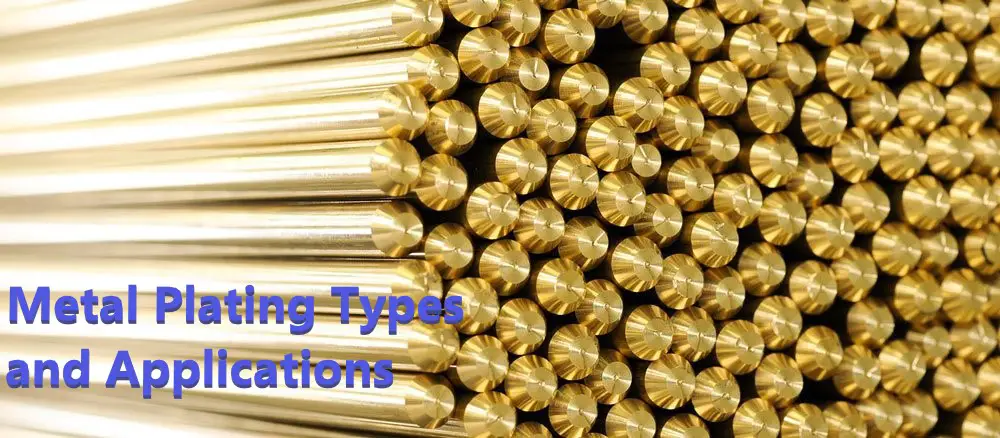Metal Plating | Types & Its Applications
Introduction
Metal plating is the process of applying an exterior coating of nickel, copper, chromium, or another metal to prevent corrosion or improve the appearance of the parent metal.
Typically, the metal is immersed in an acid solution with an anode electric current and a cathode.
The material to be plated serves as the cathode (negative electrode) of an electrolysis cell through which an electric current is conducted directly.
The needed metal is oxidized in the solution or bath (either as a complex ion or aquated cation).
The anode is often a bar of plated metal.
The metal is deposited on the work during the electrolysis process, and the metal from the bar dissolves.
Faraday’s law of electrolysis governs the process.
The plating substance is deposited on the parent metal during the electroplating process.
Electroplating is used for:
- Appearance or decoration
- Protection
- Special surface properties
- Engineering or mechanical properties
Almost any sort of metal can be plated. Rust is prevented by zinc or cadmium plating, while nickel and chrome protect against wear. The most popular industrial plating metals are zinc, chromium, and nickel.
History
Luigi Brugnatelli, an Italian scientist, electroplated silver medals with gold in 1805. The French Academy of Sciences kept the inventions hidden. Electroplating was “rediscovered” 35 years later by Russian and English scientists working independently.
The first patent for electroplating was issued in 1940. In England, factories began mass-producing solver-plated objects such as tableware, brushes, and teapots.
What Are The Components Of The Metal Plating Process?
Metal plating is a method of generating an exterior layer of copper, chromium, nickel, and other metals on a base material.
It is usually done to improve the appearance of plated material and to protect it from corrosion. Plating is one of the simple procedures that may be used on any metal found in nature. Chrome, nickel, and zinc are the most commonly used metals for industrial plating.
Preparation for cleaning metal surfaces:
- Alkaline cleaning
- Electropolishing
- Oxide removal
Metal plating:
- Electroplating
- Electrolysis plating
- Immersion plating
Treatments for protection and finish:
- Anodizing
- Phosphating
- Chromatic conversion
Typical Steps in Electroplating Process
The procedure outlined below takes around 90 minutes to perform. This is the procedure for cadmium-plating steel aircraft parts.
- Cleaning: For bonding to occur, the surface must be free of impurities.
- Rinsing and dry (if needed)
- Acid cleaning and etching: Sandblasting with aluminum oxide roughens the surface, allowing the plating metal to adhere easier.
- Rinsing (if needed)
- Conversion Coating or Plating
- Water Rinsing (1 minute)
- Chemical rinsing to increase corrosion resistance in parts
- Rinse in Hot Water
What Are The Types Of Plating?
You must be aware of the various types of metal plating available. The three most prevalent types employed in industrial processes are as follows.
Electroplating (Electrolytic Plating)
There are several types of metal plating, with electroplating being one of the most common. This is a technique for conducting electric currents through an electrolyte solution. It has two electrodes that are typically dipped into an electrolyte solution and connected to the power circuit.
Cathodes are the most common electrodes, while anodes are usually employed as coating materials. When electricity flows through a circuit, the electrolyte separates metal atoms from the anode and deposits them in a very thin layer on one of the cathodes.
For the electroplating process, various metals can be used. Zinc, silver, gold, tin, nickel, chrome, copper, platinum, and lead are among them.
Autocatalytic (Electroless Plating)
When selecting a metal plating method, electroplating is typically used. However, in some situations, an option known as electroless plating may be available. This method is simpler, less expensive, and an excellent substitute for electroplating. The procedure is also known as autocatalytic plating, which is a plating method that does not require an external power source.
This method entails plating the material with an aqueous solution before depositing it. As this is a chemical process that does not require any additional machinery or electricity, it adds catalytic reduction to the path.
Electroless plating is often appropriate for objects with a hard surface that are corrosion resistant. This makes this process an excellent choice for the marine and oil industries. Some of the most common corrosion-prone parts, such as valves and pumps, are often manufactured using an electroless plating process.
Immersion Plating (Displacement Reaction)
This is a procedure in which a nobler metal adherent layer is applied to the surface of another metal by dipping its path into a solution containing nobler metal ions. So, when you make metal components from elements like copper by immersing them in an electrolyte solution, the iron from nobler materials can coat the copper parts by releasing electrons.
It’s sometimes referred to as drop plating or metal replacement. This is a chemical method that, like electroless plating, does not require an external current. Unlike electroless plating, metal deposition is stopped when the component has been completely coated.
Immersion plating is an excellent solution for industries seeking to create a metal surface with better corrosion resistance and where. Another advantage is high electrical conductivity. It can be a fantastic alternative for industries because it can also change reflectivity and appearance and has bonding capabilities.
What Are The Applications Of Metal Plating?
Electroplating is used in a variety of sectors. It is an excellent solution for a variety of businesses.
It can be used to make a variety of items ranging from engagement rings to electrical antennas.
The following are some of the most notable cases.
Aerospace:
Several airplane components are electroplated to create a sacrificial coating. It generally extends the path’s lifespan by reducing corrosion. Because aviation components are subjected to significant temperature variations and a variety of other environmental conditions, an extra layer of metal can improve functionality while reducing wear and tear.
Home decor and art:
There is a wide variety of electroplated home decor accessible on the market. Generally, artists utilize this procedure to transform biodegradable things such as branches, bags, and flowers into long-lasting and durable creations. Electroplating allows minute details to be preserved and products to be displayed without disintegration.
Automotive:
Electroplating is the most frequent method for producing bespoke parts, particularly for concept automobiles. Hubcaps, for example, are made by electroplating type 20 concept vehicles. Even vehicle modification and restoration companies use electroplating to put chrome, nickel, and a variety of other finishes on a motorcycle and car parts.
Jewelry:
Electroplating is most likely one of the most popular procedures in the precious metal and jewelry industries.
Designers and producers in this business use this method to improve the durability, aesthetic appeal, and color of pendants, rings, bracelets, and a variety of other accessories.
Dental and medical:
Electroplating is commonly used to strengthen the outside of many dental and medical components. Gold plating is used to make tooth inlays and is useful for a variety of dental procedures. Screws, joints, plates, and other implanted pieces that are electroplated to make them more cost-effective and resistant are among the most popular. Even surgical and medical instruments such as radiological components and forceps are electroplated.
Power:
Many solar and electrical components have been electroplated to improve their electrical conductivity. The solar cell connections and other antennae are generally electroplated by the makers. Wires are also electroplated with nickel, silver, and other metals on occasion. Gold plating is applied to increase durability.
Gold can be a desirable inclusion because of its ductility and conductivity, which can extend longevity.
While there are several other uses for metal plating, these are the most common ones that make use of the electroplating process. Because metal plating has numerous advantages, it is most typically utilized by businesses seeking durability, wear resistance, and better electrical conductivity.
Plating Methods
Rack Plating Method
The most popular process is rack plating, in which the metal to be plated is hung on a frame or rack. It is a versatile technology that allows you to manage the amount of rinse water and drag-out rate.
Barrel Plating
In a closed barrel, barrel plating takes place. Where electroplating smaller items or when processing requirements/standards are lower, this technique is employed. The rinse water consumption is significant, as are the drag-out rates.
Manual Plating
Everything in manual metal plating is done by a qualified technician. It is designed for small-batch plating.
Automated Plating
Plate plating can be semi-automated or fully automated. Employees in automated operations just need to rack and unrack during the metal plating operation. Rails and hoists must be manually controlled in semi-automated processes. It is appropriate for larger pieces and slower manufacturing rates.
What Are The Key Chemicals Used In The Process?
To improve the results and boost the stability of the process, various chemicals are utilized.
To help you understand the process better, we have categorized some of the primary elements involved.
- Acids and Bases used: Caustic and HCL.
- Coatings: Chromium, Cyanide, Cadmium, Gold, Silver, Bronze, Zinc, and Brass.
- Solvents: Trichloroethylene, Benzene, Tetrachloroethylene, TZE, and Tetrachloroethylene (perchloroethylene).
Environmental Corrosion Testing
Metals are being tested in the environment to see if the electroplating procedure will protect them against corrosion. The challenge is to mimic the time it takes for corrosion to occur, which is why various types of time-based tests have been created.
An organization may set up interior or outdoor exposure stations in various instances. Other ways include applying test metals to surfaces exposed to the elements, such as vehicles traveling in cold weather. Among the specific tests are:
- Acetic Acid Salt Spray Test (also called Fog test): For testing, an acetic acid mist is utilized, which accelerates the corrosive action.
- Copper-accelerated Acetic Acid Salt Spray Test (Cass): Same as above with added copper salts.
- Corrodkote Test: Coat the electroplated piece with kaolin, a substance that contains aluminum chloride, copper nitrate, and ferric chloride. After drying, the material is placed in a humidity chamber.
- Electrochemical Corrosion Test (ECT):
- After becoming anodic, the substance is immersed in an electrolyte. In minutes, conditions are formed that cause corrosion.
- Sulfur Dioxide Test: Material is placed in a chamber that contains sulfur dioxide gas.
- Humidity Tests: These types of metal plating corrosion tests are not considered to be reliable.
Choose An Electroplating Kit
You can also select a suitable electroplating kit, such as the “Plug N’ Plate® Workshop Electroplating Kit.”
These kits provide everything you need to plate metals with other metals such as copper, nickel, tin, brass, bronze, gold, silver, chrome, and a variety of others.
It also contains the parts, technical assistance, and a user-friendly instruction manual.
This is an excellent option for metal plating on small items.
Conclusion
So there you have it: all you need to know about metal plating. It’s no surprise that metal plating is one of the most popular processes used in various sectors to generate extremely resistant compounds.
Metal plating is one of the original and most widely used treatments for boosting longevity, resistance to wear and tear corrosion resistance, and a good look. As a result, metal plating is a common and prevalent method in the jewelry business, art and decor, and aerospace.







